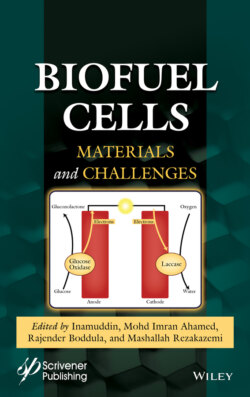Читать книгу Biofuel Cells - Группа авторов - Страница 33
2.1 Introduction to Biological Fuel Cells
ОглавлениеThe development of sustainable and renewable energy sources in line with human needs and the reduction of dependence on fossil fuels is the inevitable need of the world at present and in the future. Since the late 1960s, biofuel cells (BFCs) have attracted great interest by researchers to produce clean and renewable electrical energy among alternative energy sources. BFCs, which consist of two sub-categories: enzymatic fuel cells (EFCs) and microbial fuel cells (MFCs), are operated with the same logic as conventional fuel cells for energy production. However, the energy generated from BFCs is at the micro or milliwatt level and cannot be compared with other alternative sources such as hydroelectric, solar and wind energy [1]. BFCs are thought to be a renewable power source for mini/micro smart technological/medical devices that have been developed and used to make life easier in recent years. With these innovative approaches, wearable and implantable BFCs have attracted great interest by researchers.
The difference of BFCs from conventional fuel cells is that they use microorganisms or enzymes as the catalysts instead of expensive metal catalysts. BFCs convert chemical energy with biochemical reactions directly into electrical energy. When fuel is added to the BFC system, one or more oxidation reactions occur on the anode side, while the reduction reaction occurs on the cathode side, simultaneously. The renewable fuels such as sugars (glucose, fructose, lactose), lactate, pyruvate and ethanol can be used to produce energy [2]. Among them, glucose is the most preferred fuel by researchers since it is an important and relatively abundant source of energy in living organisms [1].
MFCs are based on microorganisms while EFCs are enzyme-based [3]. MFCs consist of anodic and cathodic chambers separated by cationic membrane produce energy by the biodegradation of organic compounds. Organic/inorganic compounds are oxidized by microbes reside in anode chamber and generate electrons and protons. The electrons are transferred to anode surface and then move to cathode chamber through an external circuit. Meanwhile, protons are transported to the cathode chamber pass through the cationic membrane. The transferred electron and proton combine with oxygen to form water in cathode chamber [3, 4]. It has been reported that the produced energy from MFCs is enough to power for the operation of different types of robots. However, these studies are still being developing [1]. A wide variety of municipal and industrial wastewater types are utilized as fuel to generate eco-friendly energy, and this process simultaneously provides the purification of wastewaters [5]. In addition, many compounds such as carbohydrates [6–8] organic acids [9–12], alcohols [13], inorganic compounds such as sulfate [14] and complex compunds such as starch [15–17] are used as fuel during the development of MFC technology.
An EFC system is comprised of an anode, a cathode, a reference electrode and a counter electrode. A typical EFC is presented schematically in Figure 2.1. The fuel is oxidized by immobilized enzyme and the released electrons are transferred to the anode electrode material, then flow through to the cathode side with an applied anodic potential. At the same time, electrons are captured by the cathode electrode material under the applied cathodic potential. The cathodic enzyme reduces oxygen to water by using these electrons. The renewable energy is generated by these reactions as long as fuel is added to the EFC system. While not realistic, one of the pioneering ideas trying to turn EFCs into a device is cardiac pacemakers. From this innovative idea, many researchers have turned to studies which EFCs will power portable electronic and wearable or implantable medical devices. However, there are no commercial products yet due to major difficulties such as operational stability, sterilization and biocompatibility [1].
Figure 2.1 Schematic representation of a typical EFC.
In this chapter, important developments, innovative approaches and future perspectives in BFCs have been discussed.
